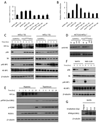mTORC1 signaling under hypoxic conditions is controlled by ATM-dependent phosphorylation of HIF-1α
- PMID: 21095582
- PMCID: PMC3004768
- DOI: 10.1016/j.molcel.2010.10.030
mTORC1 signaling under hypoxic conditions is controlled by ATM-dependent phosphorylation of HIF-1α
Abstract
The mTOR complex-1 (mTORC1) coordinates cell growth and metabolism, acting as a restriction point under stress conditions such as low oxygen tension (hypoxia). Hypoxia suppresses mTORC1 signaling. However, the signals by which hypoxia suppresses mTORC1 are only partially understood, and a direct link between hypoxia-driven physiological stress and the regulation of mTORC1 signaling is unknown. Here we show that hypoxia results in ataxia telangiectasia mutated (ATM)-dependent phosphorylation of hypoxia-inducible factor 1-alpha (HIF-1α) on serine(696) and mediates downregulation of mTORC1 signaling. Deregulation of these pathways in pediatric solid tumor xenografts suggests a link between mTORC1 dysregulation and solid tumor development and points to an important role for hypoxic regulation of mTORC1 activity in tumor development.
Copyright © 2010 Elsevier Inc. All rights reserved.
Conflict of interest statement
The authors are unaware of any actual or perceived conflict of interests.
Figures







Comment in
-
ATM: Promoter of metabolic "cost" reduction and "savings" usage during hypoxia through mTORC1 regulation.Mol Cell. 2010 Nov 24;40(4):501-2. doi: 10.1016/j.molcel.2010.11.013. Mol Cell. 2010. PMID: 21095578
Similar articles
-
Regulation of mammalian target of rapamycin complex 1 (mTORC1) by hypoxia: causes and consequences.Target Oncol. 2011 Jun;6(2):95-102. doi: 10.1007/s11523-011-0173-x. Epub 2011 Apr 16. Target Oncol. 2011. PMID: 21499767 Review.
-
ATM signals to TSC2 in the cytoplasm to regulate mTORC1 in response to ROS.Proc Natl Acad Sci U S A. 2010 Mar 2;107(9):4153-8. doi: 10.1073/pnas.0913860107. Epub 2010 Feb 16. Proc Natl Acad Sci U S A. 2010. PMID: 20160076 Free PMC article.
-
Chemotherapy-mediated p53-dependent DNA damage response in clear cell renal cell carcinoma: role of the mTORC1/2 and hypoxia-inducible factor pathways.Cell Death Dis. 2013 Oct 17;4(10):e865. doi: 10.1038/cddis.2013.395. Cell Death Dis. 2013. PMID: 24136229 Free PMC article.
-
Suppression of hypoxia-inducible factor 1α (HIF-1α) by tirapazamine is dependent on eIF2α phosphorylation rather than the mTORC1/4E-BP1 pathway.PLoS One. 2010 Nov 9;5(11):e13910. doi: 10.1371/journal.pone.0013910. PLoS One. 2010. PMID: 21085474 Free PMC article.
-
Checking in on hypoxia/reoxygenation.Cell Cycle. 2006 Jun;5(12):1304-7. doi: 10.4161/cc.5.12.2811. Epub 2006 Jun 15. Cell Cycle. 2006. PMID: 16760660 Review.
Cited by
-
The Breast Cancer Tumor Suppressor TRIM29 Is Expressed via ATM-dependent Signaling in Response to Hypoxia.J Biol Chem. 2016 Oct 7;291(41):21541-21552. doi: 10.1074/jbc.M116.730960. Epub 2016 Aug 17. J Biol Chem. 2016. PMID: 27535224 Free PMC article.
-
An Emerging Regulatory Role for the Tumor Microenvironment in the DNA Damage Response to Double-Strand Breaks.Mol Cancer Res. 2020 Feb;18(2):185-193. doi: 10.1158/1541-7786.MCR-19-0665. Epub 2019 Nov 1. Mol Cancer Res. 2020. PMID: 31676722 Free PMC article. Review.
-
DNA Double-Strand Break Repair Inhibitors: YU238259, A12B4C3 and DDRI-18 Overcome the Cisplatin Resistance in Human Ovarian Cancer Cells, but Not under Hypoxia Conditions.Curr Issues Mol Biol. 2023 Sep 28;45(10):7915-7932. doi: 10.3390/cimb45100500. Curr Issues Mol Biol. 2023. PMID: 37886943 Free PMC article.
-
mTOR in Lung Neoplasms.Pathol Oncol Res. 2020 Jan;26(1):35-48. doi: 10.1007/s12253-020-00796-1. Epub 2020 Feb 3. Pathol Oncol Res. 2020. PMID: 32016810 Review.
-
Hypoxia inducible factor pathway inhibitors as anticancer therapeutics.Future Med Chem. 2013 Apr;5(5):553-72. doi: 10.4155/fmc.13.17. Future Med Chem. 2013. PMID: 23573973 Free PMC article. Review.
References
-
- Arsham AM, Howell JJ, Simon MC. A novel hypoxia-inducible factor-independent hypoxic response regulating mammalian target of rapamycin and its targets. J Biol Chem. 2003;278:29655–29660. - PubMed
-
- Ateghang B, Wartenberg M, Gassmann M, Sauer H. Regulation of cardiotrophin-1 expression in mouse embryonic stem cells by HIF-1alpha and intracellular reactive oxygen species. J Cell Sci. 2006;119:1043–1052. - PubMed
-
- Bartkova J, Horejsi Z, Koed K, Kramer A, Tort F, Zieger K, Guldberg P, Sehested M, Nesland JM, Lukas C, et al. DNA damage response as a candidate anti-cancer barrier in early human tumorigenesis. Nature. 2005;434:864–870. - PubMed
-
- Bartkova J, Rezaei N, Liontos M, Karakaidos P, Kletsas D, Issaeva N, Vassiliou LV, Kolettas E, Niforou K, Zoumpourlis VC, et al. Oncogene-induced senescence is part of the tumorigenesis barrier imposed by DNA damage checkpoints. Nature. 2006;444:633–637. - PubMed
Publication types
MeSH terms
Substances
Grants and funding
LinkOut - more resources
Full Text Sources
Other Literature Sources
Molecular Biology Databases
Research Materials
Miscellaneous

